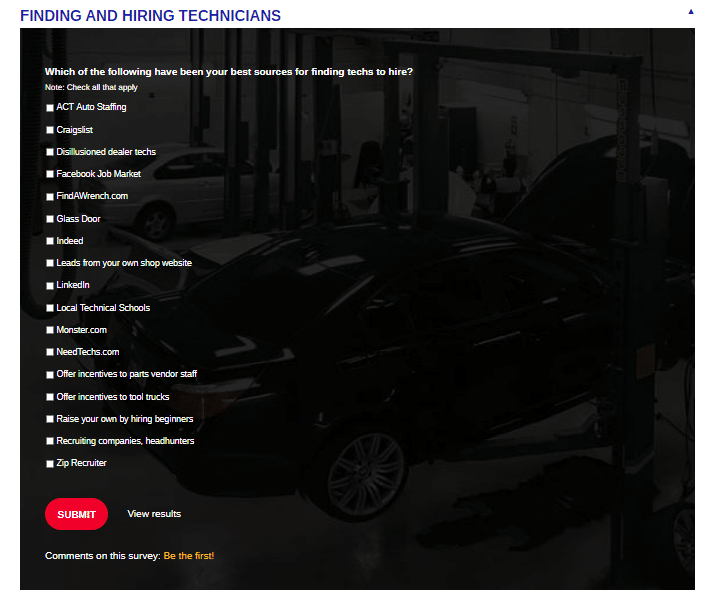Survey: Finding and Hiring Technicians

The Automotive Management Network currently has a poll about finding and hiring technicians. If you have not yet taken it, please go here and share your experience. We would appreciate learning what you can tell us about how your shop finds techs, so please check all answers that apply.
Where to Go for Finding and Hiring Technicians
Here is a screenshot of all of the options that are listed.
Online Recruitment – Job Boards
There are so many ways online to try to connect with people looking for jobs. Not all of them will have the same effectiveness, but the first one that most job seekers and managers think about for hiring is online job boards. Job boards vary in usefulness and popularity. Typically, people will not list information on all available job boards; they’ll choose the ones they think will get the most views and the best response. In our poll the online job boards we list are:
- ACT Auto Staffing
- Craigslist
- Facebook Job Market
- FindAWrench.com
- Glass Door
- Indeed
- NeedTechs.com
- Monster.com
- Zip Recruiter
Of the above job boards, people who have taken the poll so far have most often used Indeed. The next most commonly used job board site is Facebook Job Market, and after that Craigslist and Zip Recruiter. None of the other job boards have been noted as used by our polled respondents yet.
LinkedIn is a networking site. It’s most often used by marketers and people with white collar jobs. It can be used to search for jobs; however, no one in our poll has stated they’ve used LinkedIn to locate techs.
Face-to-Face Networking
In our poll we list 6 face-to-face networking strategies:
- Disillusioned dealer techs
- Leads from your own shop website
- Local technical schools
- Offer incentives to parts vendor staff
- Offer incentives to tool trucks
- Raise your own by hiring beginners
We have discussed many of these strategies in previous blog pieces about the shortage of techs in auto repair. Shop managers have commented frequently about finding techs while they are still in school. Technical training isn’t enough, but with mentoring and learning on the job, the right fit can happen and be a mutually satisfying arrangement for both parties. Both this strategy and “Raise your own by hiring beginners” were selected by auto shop managers twice. “Disillusioned auto techs” was also chosen twice.
Of the above six options, though, the most commonly selected one was “Leads from your own shop website.” This is an excellent argument for developing your company’s website, keeping it up to date, and using it as an active recruiting tool. A website can be useful for a number of reasons, not just for attracting customers or advertising specials. Shops need techs so, if you have not already done so, creating a job opportunities page on your website would be a good idea.
Another possibility is to hire a professional recruiter or headhunter to find candidates. Both headhunters and recruiters work to attract qualified professionals to companies. A recruiter will find potential employees from a general talent pool. They may be directly involved in the hiring process and sit in on interviews and follow up with job applicants. A headhunter often works for an outside agency and will woo skilled and talented people from other positions.
This option was only mentioned by one polled responder. It would be interesting to hear from members if cost is the determining factor for not using professional recruiters or headhunters or if they simply prefer to do the work themselves or keep it in house.
Of all the above options, the most commonly chosen answer for the question of where shops are finding their best techs was using Indeed. Indeed is a very popular job posting site, so this is not unexpected.
However, this poll was only recently posted, and it does not yet have a large number of responses that would make it more representative. It’s helpful for auto shop managers to share their own experiences because what works in one geographical area may differ from another. Not all shops or managers are the same either, so their strategies for finding and hiring technicians will be different. Please take a minute to weigh in on this poll. The shortage of techs is an issue that everyone in auto repair faces. The more we know about how to solve this problem, the better off we all are.



Here’s what I believe…
The shortage of workers in the trades is a complex issue with several contributing factors. Here are a few reasons why the trades may struggle to find workers:
1. Perception: Over the years, there has been a societal shift towards placing greater emphasis on obtaining a college degree rather than pursuing a trade. As a result, many young people may not consider the trades as a viable career option, leading to a smaller pool of potential workers.
2. Skills Gap: The trades often require specialized skills and technical knowledge. However, due to the lack of emphasis on vocational training in some educational systems, there is a gap between the skills required for these jobs and the skills possessed by potential workers. This disconnect can make it challenging for employers to find qualified candidates.
3. Aging Workforce: Many skilled tradespeople are nearing retirement age, and there may not be enough new workers entering the trades to replace them. This demographic shift exacerbates the shortage and further highlights the need for attracting and training new talent.
4. Perception of Job Stability: There may be a perception that jobs in the trades are less stable or have limited opportunities for career growth. This perception can deter individuals from pursuing careers in the trades, leading to a smaller labor pool.
Addressing these challenges requires a multi-faceted approach. It involves raising awareness about the benefits and opportunities within the trades, promoting vocational training and apprenticeship programs, and bridging the gap between industry needs and educational curricula. Additionally, offering competitive salaries, benefits, and career advancement opportunities can help attract and retain workers in the trades.